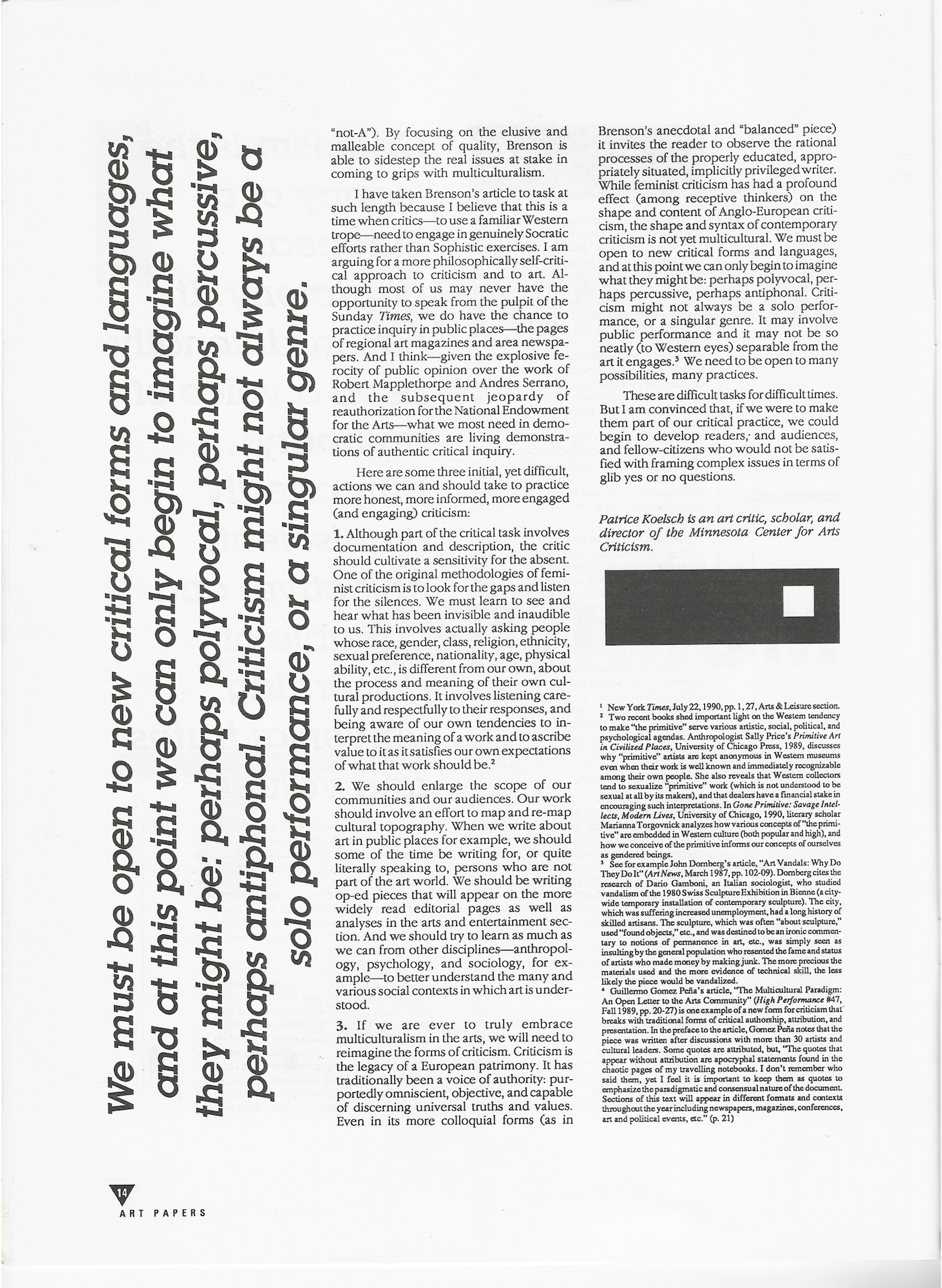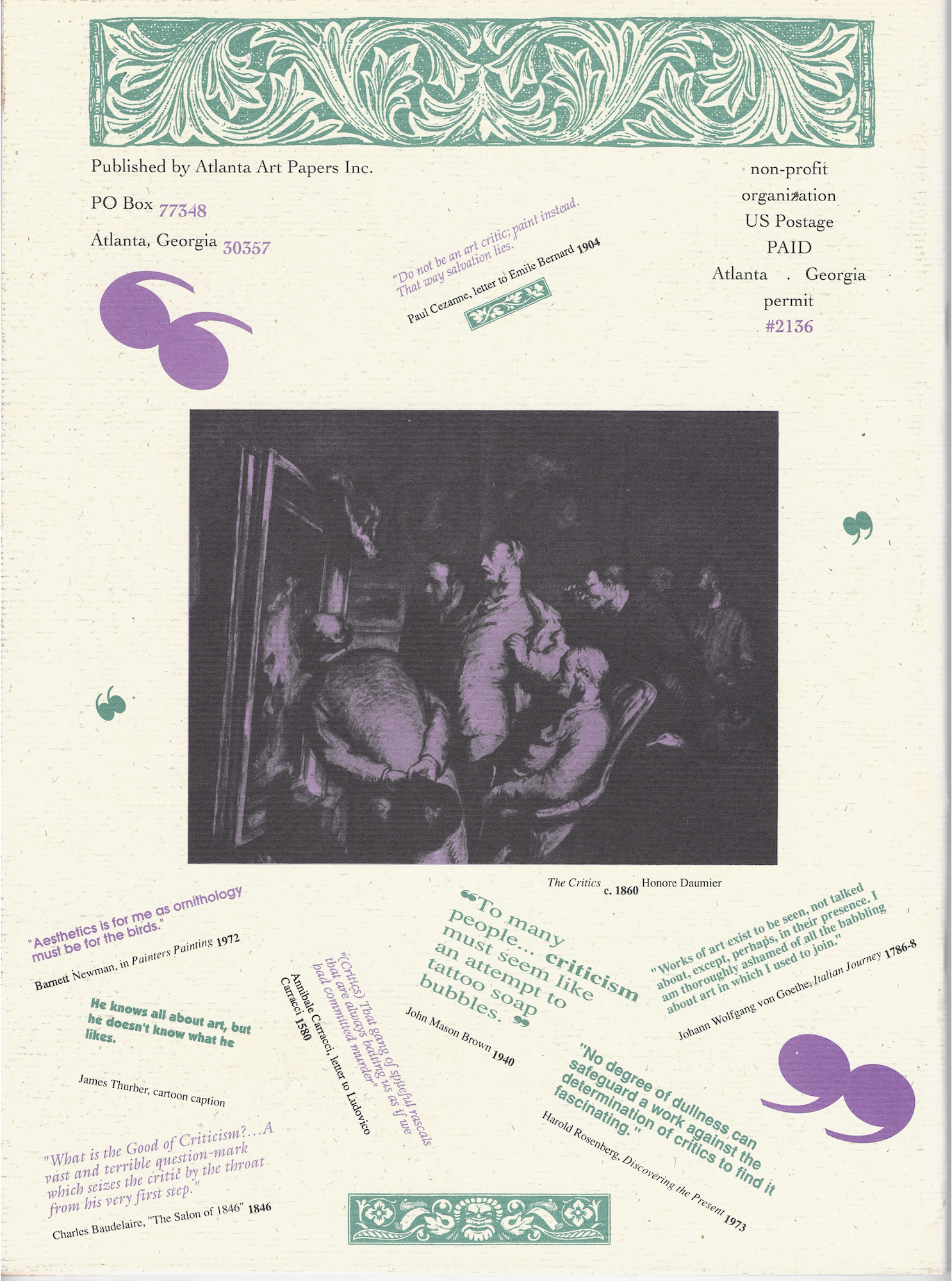The Criticism of Quality and the Quality of Criticism
Share:
This essay was originally published in ART PAPERS November/Decmber 1990, Vol 14, Issue 6.
The New York Times headline was provocative: “Is ‘Quality’ An Idea Whose Time Has Gone?”1 Michael Brenson plunges into the question with a chatty but instructive anecdote about his exchange with another American art critic at the opening of the multicultural “Magicians of the Earth” exhibition in Paris. He announces to his fellow critic that he finds “the selection of the Western artists troublesome…[and] some of the non-Western artists were not very good.” Much to his surprise apparently, Brenson’s colleague was not interested in discussing his critical reservations. Brenson concludes the vignette in this way: “Ah, the quality issue,’ she said, with a wary smile that told me in no uncertain terms that this was an approach to the show she wanted no part of.”
Brenson then assures the skeptical Sunday morning reader that, “Unlikely as it may seem, this common, everyday word has become a lightning rod for a stormy debate in the art world. Swirling around it are arguments over the virtues of form versus content, Western values versus non-Western values, men versus women.” At this point, the astute reader should be able to guess the course of the ensuing 45 newspaper para- graphs. Brenson presents both sides of what he takes to be the arguments for and against invoking a concept of “quality” in judgments about the value of art. He allows that both positions have their merits and their excesses. He rehearses the seminal moments of modernist and postmodernist aesthetics, waxes eloquent on the transcendent and universal experience of “esthetic emotion,” and reduces the complex critique of Eurocentric aesthetics to a misguided rejection of form for the sake of content. Thus, Brenson is able to resolve “the quality question” by insisting that the most powerful postmodern and non-Western work succeeds because the form enables the content to be expressed effectively. So the best feminist, gay, Hispanic, black, etc., art is infused with quality even if its makers and admirers find it politically incorrect to say so.
Brenson’s piece does have substantial heuristic value, not however as a resolution of “the quality issue,” but as an exemplar of a critical polemic posing as a critical investigation. Brenson adopts the purportedly impersonal mantle of the objectively judicious journalist for most of the article. However, the introductory recapitulation of his encounter at the “Magicians of the Earth” show reveals what is covertly at stake—masculine privilege. His unidentified female colleague is not interested in what he has to say and he is appalled—ostensibly by her failure to behave like a responsible American art critic trained to make aesthetic judgments. However, I suggest an additional reading on a more personal level, namely that he is also offended because she doesn’t think that his values and opinions are germane. She doesn’t invite him to inform her. Instead, she smiles at him and dismisses him. She does not behave as a woman should.
In his account of this brief and disconcerting conversation (an account designed to make readers empathize with him), Brenson fails to acknowledge that their conversation—and the way in which each critic experiences the exhibition—might have anything to do with gender. But this, of course, is at the heart of what he trivializes as “the quality question.”
I take Brenson to task here for several reasons (all of which bear on the concerns of this gathering): the power of his position and his authority to frame the terms of the discussion in the public mind; the importance of the issues and the difficulty in comprehending their complexities; and the need to have more honest and genuinely self-critical art criticism.
As art critic for the most prestigious American newspaper, Brenson speaks indirectly to and for the interests of the New York Times, and directly to its readers: i.e., art producers and presenters (artists and advertisers) and art consumers (collectors, patrons, and museum goers). Just because of his position, whatever topic Brenson tackles becomes a matter for serious consideration by his readers. Thus, Brenson has the unusual opportunity to present controversial ideas and concerns that usually don’t filter into the conversations of his many intellectually insulated readers.
Instead of doing justice to the complexity of the issues at stake, Brenson at the outset reports as his overall impression of a representative exhibition that some of the work in question is “not very good” and some of the artists are “troublesome.” While presumably giving “both sides” of the issue a hearing, and admitting that, “The divisions are not always absolute,” he then identifies himself with majoritarian interests with such hyperbolic remarks as “those who reject the word [quality]…often exhibit an alarming readiness to set up a bogeyman called the heterosexual white male, make him the scapegoat for everything bad in human history, and try to discredit the word quality—and with it all of Western civilization—by identifying it with him alone.”
Moreover, Brenson’s characterization of the controversy as encompassing two camps (quality: pro and con) obliterates the significant cultural distinctions and experiences between various marginalized peoples (e.g., the differences between indigenous people whose ancestors were colonized, and white middle-class feminist lesbians). Brenson falls into the dichotomous Cartesian thinking that is a staple of Western logic (there is “A” and then there is “not-A”). By focusing on the elusive and malleable concept of quality, Brenson is able to sidestep the real issues at stake in coming to grips with multiculturalism.
I have taken Brenson’s article to task at such length because I believe that this is a time when critics—to use a familiar Western trope—need to engage in genuinely Socratic efforts rather than Sophistic exercises. I am arguing for a more philosophically self-critical approach to criticism and to art. Although most of us may never have the opportunity to speak from the pulpit of the Sunday Times, we do have the chance to practice inquiry in public places—the pages of regional art magazines and area newspapers. And I think—given the explosive ferocity of public opinion over the work of Robert Mapplethorpe and Andres Serrano, and the subsequent jeopardy of reauthorization for the National Endowment for the Arts—what we most need in democratic communities are living demonstrations of authentic critical inquiry.
Here are some three initial, yet difficult, actions we can and should take to practice more honest, more informed, more engaged (and engaging) criticism:
- Although part of the critical task involves documentation and description, the critic should cultivate a sensitivity for the absent. One of the original methodologies of femi- nist criticism is to look for the gaps and listen for the silences. We must learn to see and hear what has been invisible and inaudible to us. This involves actually asking people whose race, gender, class, religion, ethnicity, sexual preference, nationality, age, physical ability, etc., is different from our own, about the process and meaning of their own cultural productions. It involves listening carefully and respectfully to their responses, and being aware of our own tendencies to interpret the meaning of a work and to ascribe value to it as it satisfies our own expectations of what that work should be.2
- We should enlarge the scope of our communities and our audiences. Our work should involve an effort to map and re-map cultural topography. When we write about art in public places for example, we should some of the time be writing for, or quite literally speaking to, persons who are not part of the art world. We should be writing op-ed pieces that will appear on the more widely read editorial pages as well as analyses in the arts and entertainment section. And we should try to learn as much as we can from other disciplines—anthropology, psychology, and sociology, for example—to better understand the many and various social contexts in which art is understood.
- If we are ever to truly embrace multiculturalism in the arts, we will need to reimagine the forms of criticism. Criticism is the legacy of a European patrimony. It has traditionally been a voice of authority: purportedly omniscient, objective, and capable of discerning universal truths and values. Even in its more colloquial forms (as in Brenson’s anecdotal and “balanced” piece) it invites the reader to observe the rational processes of the properly educated, appropriately situated, implicitly privileged writer. While feminist criticism has had a profound effect (among receptive thinkers) on the shape and content of Anglo-European criticism, the shape and syntax of contemporary criticism is not yet multicultural. We must be open to new critical forms and languages, and at this point we can only begin to imagine what they might be: perhaps polyvocal, perhaps percussive, perhaps antiphonal. Criticism might not always be a solo performance, or a singular genre. It may involve public performance and it may not be so neatly (to Western eyes) separable from the art it engages.3 We need to be open to many possibilities, many practices.
These are difficult tasks for difficult times. But I am convinced that, if we were to make them part of our critical practice, we could begin to develop readers, and audiences, and fellow-citizens who would not be satisfied with framing complex issues in terms of glib yes or no questions.
Patrice Koelsch was an art critic, scholar, and director of the Minnesota Center for Arts Criticism.
References
| ↑1 | New York Times, July 22, 1990, pp. 1, 27, Arts & Leisure section. |
|---|---|
| ↑2 | Two recent books shed important light on the Western tendency to make “the primitive” serve various artistic, social, political, and psychological agendas. Anthropologist Sally Price’s Primitive Art in Civilized Places, University of Chicago Press, 1989, discusses why “primitive” artists are kept anonymous in Western museums even when their work is well known and immediately recognizable among their own people. She also reveals that Western collectors tend to sexualize “primitive” work (which is not understood to be sexual at all by its makers), and that dealers have a financial stake in encouraging such interpretations. In Gone Primitive: Savage Intellects, Modern Lives, University of Chicago, 1990, literary scholar Marianna Torgovnick analyzes how various concepts of “the primitive” are embedded in Western culture (both popular and high), and how we conceive of the primitive informs our concepts of ourselves as gendered beings. |
| ↑3 | See for example John Dornberg’s article, “Art Vandals: Why Do They Do It” (Art News, March 1987, pp. 102-09). Domberg cites the research of Dario Gamboni, an Italian sociologist, who studied vandalism of the 1980 Swiss Sculpture Exhibition in Bienne (a city- wide temporary installation of contemporary sculpture). The city, which was suffering increased unemployment, had a long history of skilled artisans. The sculpture, which was often “about sculpture,” used “found objects,” etc., and was destined to be an ironic commen- tary to notions of permanence in art, etc., was simply seen as insulting by the general population who resented the fame and status of artists who made money by making junk. The more precious the materials used and the more evidence of technical skill, the less likely the piece would be vandalized. |




